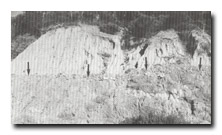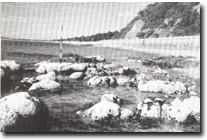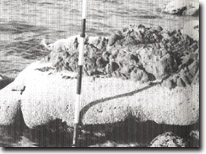82 Anthonys Nose - Fault Scarp
|
This information has been developed from one or more of these publications:
|
| Location | 199541. 1 km northeast of McCrae shopping area. The site includes rocks in the intertidal zone and the cliff face on the south of the Nepean Highway. |  Site 82, Conglomerate (arrowed) overlying granite, Anthonys Nose |
Access | Nepean Highway. | |
Ownership/Managing Authority | Crown land, Shire of Flinders, Dromana Foreshore Committee of Management. | |
Site Description | Along the southern side of the Nepean Highway 1 km northeast of McCrae is a steep slope exposing Dromana Granite overlain by unconsolidated sand deposits. Between the two formations, and about 10 m above road level, is a conglomerate/gravel bed up to 2 m thick composed of smooth, rounded pebbles set in a coarse sandy matrix. The bed is exposed over a distance of approximately 100 m and is only accessible from a steep gully above the deposit. Granodiorite also outcrops at low tide discontinuously in front of the sea wall. Both here and in the cliff it is closely fractured and granulated along shear zones suggesting it has been effected by movement of Selwyns Fault. The gravel bed is either an uplifted beach gravel or a high energy stream deposit. | |
Of additional interest on the littoral outcrops is the occurrence of a thick encrustation of the tube worm Galeolaria caespitosa with a well-defined upper growth limit. | ||
Significance | Regional. The site is the only coastal exposure of Dromana Granite (the intrusion that forms Arthurs Seat). The conglomerate bed is an example of a major unconformity with the bed indicating either a phase of high energy stream conditions or uplift of a coastal deposit. It is therefore an important interpretation site to display the geological history of Arthurs Sea. The horizontal upper limit of the Galeolaria growth is a very clear example of the growth of this inter-tidal organism, and could be a monitoring site in future studies of sea level rise in Port Phillip Bay. | |
Management Considerations | Class 2. The conglomerate in the cliff should be left exposed in its present state. Any road widening projects should be designed to maintain an exposure of this material and the unconformity. The sea level outcrops with Galeolaria should be left exposed because of their potential use as monitoring sites. This aspect of site significance is open to review if the Galeolaria sites prove to be insufficient for ongoing study of sea level changes. | |
References | Baker, G. (1938) | |
 Site 82, Galeolaria growing on fractured |  Site 82, Detail of Galeolaria growth, Anthonys Nose |
 Site 82, Anthonys Nose |


